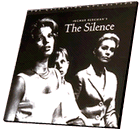

Sweden drama
1963
bw 96 min.
Director: Ingmar Bergman
CLV: $49.95 - available
1 disc, catalog # CC1309L
VHS: available from Home Vision Cinema
Two women, Anna and Ester, accompanied by Johan,
Anna's 10-year-old son, travel slowly through the night by train into
a foreign country that seems to be at war. They are sisters, it will
turn out, perhaps lovers. We will never discover the reason for their
journey, to a place where the inhabitants, the culture, and the
language are unknown to them. Perhaps it is to pare down or discard
the normal trappings of their lives, to take the consequences of who
they turn out to be.
The Silence (1963) was originally titled God's Silence, and
it is the third in what Bergman refers to as a trilogy, whose previous two
films -- Through a Glass Darkly (1961) and Winter Light (1963) --
explore explicit questions of religious faith. Following his great
international successes with Smiles of a Summer Night (1955) and The
Seventh Seal (1957), Bergman here tries to come to terms with the pious
rigidity and strangled emotional life of his own upbringing at the hands of a
father who was Lutheran clergyman and later court chaplain to the King of
Sweden.
But both earthly and heavenly fathers are absent fromThe
Silence, whose bleak setting is based on Bergman's own experiences of
European cities after World War II. Outside is an incomprehensible world of
unreadable street signs, surging crowds, and tanks roaring in the middle of the
night. Inside is a formerly grand Hotel Europa, within which the three
travellers have taken rooms.
The Silenceis in part a prelude to later
films, in which Bergman has shifted his focus from God to people, from theology
to psychology. But ideas are inert without visual expression, and it is
Bergman's genius to invite us by extreme closeups to enter the mystery of
people, of their faces. This preoccupation with faces, what they reveal and
what they hide, is enhanced in The Silence, as in so many of Bergman's
films, by the reappearance of brilliant actors and actresses from his "stock
company." Ingrid Thulin and Gunnel Lindblom are both in Winter Light,
and Jorgen Lindstrom shows up at the beginning of Persona (1966). In the
bare rooms of The Silence, where Anna and Ester battle each other for
Johan's soul, Bergman intensifies the exploration of light and time which he
began in Winter Light -- crucially aided by cinematographer Sven
Nykvist, with whom he has worked for most of his career.
The unfathomable
"silence" of this city has reduced the adults in the triangle almost to a zero
level of communication with the outside world. Every personal connection is
oblique and truncated, creating an ominous atmosphere in which gestures and
symbols are often fugitive or vaguely menacing. Bergman calls it "a rendering
of hell on earth -- my hell." But his hell is also much like what the real
experience of travel can become, when ignorance of language and custom provokes
a helpless regression to childhood and its sometimes desperate effort to
decipher meaning.
For the curious young Johan, wandering the corridors of the
strangely vacant hotel, the brooding foreign city is merely the shell of an
adult world whose impenetrable emotional climate is determined by his mother
and aunt. (This is made more palpable by the pervasive heat and unrelieved
sweating.) As Bergman has remarked, "My impulse has nothing to do with
intellect or symbolism: it has only to do with dreams and longing, with hopes
and desires, with passion."
In a theme Bergman will explore in Persona,
Anna and Ester form two sides of a whole person. Anna is defined almost
entirely through her physicality -- washing, anointing herself with perfume and
lotions, getting dressed and undressed, having sex, watching others having sex.
Ester, the translator with her typewriter, paper and pens, is instead a
creature of language -- suffering from lung disease that suffocates her,
masturbating, smoking, drinking, and thinking of sex as a mechanical matter of
"erections and secretions" that disgust her. Her body in ruin, only words seem
to keep her alive.
Amid the noise, music and silence that layer the
soundtrack, Anna and Ester are locked in a cryptic struggle that plays out
before Johan's eyes and in his feelings. As in many of Bergman's films from
this period on, the lessons of human nature are to be learned from the lives of
women -- an intriguing point of comparison between his trilogy and Antonioni's
L'Avventura (1960), La Notte (1961), and L'Eclipse (1962).
Although we see many things that he does not, Johan's perspective is the spine
of the film. It is the movement of his sympathies from his seductive mother to
his intellectual, ailing aunt that gives coherence and force to Bergman's
meditation on human frailty.
-- Leo Braudy
CREDITS
Directed by:
Ingmar Bergman
Photography by: Sven Nykvist
Set Design by: P. A.
Lundgren
Costumes by: Marik Vos
Edited by: Ulla Ryghe





